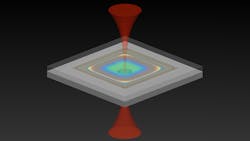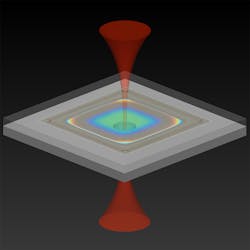Researchers at the National Institute of Technology (NIST) have developed a new type of accelerometer based on lasers and optomechanical principles rather than the traditional mechanical strain gauges used in conventional accelerometers. The device, or at least the first prototype, consists of a pair of silicon chips and is only a millimeter thick. It is much smaller and more accurate than current alternatives and could find use in aircraft and spacecraft, self-driving cars, and even cellphones and tablets. It could also be used in navigation systems where GPS isn’t available, such as in submarines and some satellites.
Not only is the NIST device, known as an optomechanical accelerometer, much more precise than the best commercial accelerometers, it does not need to undergo the time-consuming process of periodic calibrations. In fact, because the instrument uses laser light of a known frequency to measure acceleration, it may ultimately serve as a portable reference standard to calibrate other accelerometers now on the market, making them more accurate.
The prototype device consists of two layers of thin silicon. The bottom layer contains an object, the proof mass, suspended by thin silicon beams above a cavity. It can move freely up and down (the axis in which it measures acceleration) as it responds to positive and negative accelerations. The proof mass also has a reflective surface on its top side. The upper layer has a downward-pointing, immovable concave mirror, the accelerometer’s fixed reference point.
The two reflecting surfaces and the empty space between them form an optical cavity in which an IR laser beam of the right wavelength can resonate—or bounce back and forth—between the mirrors, building in intensity. That wavelength is determined by the distance between the two mirrors. If the proof mass moves due to acceleration, it changes the distance between the mirrors and the resonant wavelength changes along with it. This changed frequency and resulting wavelength are measured by a highly accurate optical frequency comb.
For an animated look at how the new accelerometer works, click here.
This design uses the simple and easy-to-model dynamic relationship between the distance the proof mass moves and the acceleration based on first principles of physics. In short, the proof mass and supporting beams behave as a simple spring, or harmonic oscillator, that vibrates at a single frequency in the accelerometer’s operating range.
The simple response let the team reduce measurement errors over the range of acceleration frequencies from 1 to 20 kHz. This means the device never needs to be calibrated, a definite advantage over commercial accelerometers that need to undergo time-consuming and expensive calibration procedures.
So far, the NIST team has made several improvements that have reduced the device’s error to nearly 1%. The device can detect motions of the proof mass that are less than one hundred-thousandth the diameter of a hydrogen atom and detects accelerations as small as 32 billionths of a g, the acceleration due to Earth’s gravity. That makes it more sensitive than other accelerometers on the market with similar size and bandwidth.
With further improvements, the NIST accelerometer could also be used as a portable, highly accurate reference source for calibrating other accelerometers outside the laboratory.

